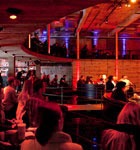From fashion to performing arts, New York City has long been known for its thriving art communities. And, since 1995, Robert Elmes and his Galapagos Art Space have contributed significantly toward molding the thriving New York cultural ecosystem. As a participation-based art center focused on emerging to mid-career artists, Galapagos quickly made a name for itself as a catalyst for the Williamsburg community. “As a premium outlet for actors, theater artists, cabaret performers, musicians, as well as 2-D and 3-D artists in our gallery, we really reflected what was happening in Williamsburg during the 1990s as it established itself as a creative community,” Elmes says.
However, as Williamsburg became increasingly popular, it eventually priced the artists out of the market. The evolution ultimately prompted Elmes to move Galapagos from Williamsburg to Dumbo (Down Under the Manhattan Bridge Overpass). After searching for an ideal location, Elmes decided to renovate a space initially built in 1904 by Turner Construction Company. “We gutted everything that was added to the building over the years and brought it back to its concrete shell,” he says. “This gave us a wonderful canvas to build what we knew would be an incredible design capable of drawing people into the Dumbo area.”

Elmes saw the move to build a LEED-certified venue as a wonderful opportunity for two reasons—it would make Galapagos a leader in the cultural sphere, and the venue would recognize crucial cost efficiencies going forward. “As a result of our decision to renovate using LEED principles, we now run an efficient building,” he says. “This gives us an advantage in presenting artists who we would not … be able to present in a higher cost environment.”
One of the most unique components of the Galapagos Art Space is the 1,600-square-foot lake inside the building, which was constructed by dropping the floor below street grade. “It essentially serves as a heat sink, wicking heat away in the summer and connecting us to the ground under the building to provide a little heat throughout the winter,” Elmes says. “We further cued off of Turner’s original design and concrete concept by building the interior out of concrete as well. To keep within LEED parameters, we used managed-forest wood for the concrete forms and recycled steel throughout. To fully incorporate the lake into the space, we built an operatic style mezzanine to surround the lake.”
According to Elmes, the renovation’s primary challenge centered on educating the trades on what the process would mean to them and their ability to embrace sustainable practices into their operations. “As a cultural client, we were taking the time to do the project properly,” he says. “Some of the trades were interested in LEED principles but approached the project with skepticism. This was a level of conversation that many of the trades were not used to engaging in, but fortunately we were able to build a collaborative relationship.”
In addition to adding beauty and distinctiveness, the venue’s green approach is paying rewards. For instance, energy consumption is around 2.5 watts per square foot. “Awareness has been a huge plus,” Elmes says. “We do not have materials that are off-gassing in our facility. Green takes into account the staff’s use of the building, and we take into account the audience’s use as well.”
The lower cost of operating the building also allows Galapagos to refine its focus on the artist, Elmes says. “We currently have sixteen artists in residence and another 25 individual artists who are performing in our shows,” he says. “The lower cost means we can invest our time into the artists’ career and work. We have more influence in developing artists.”

